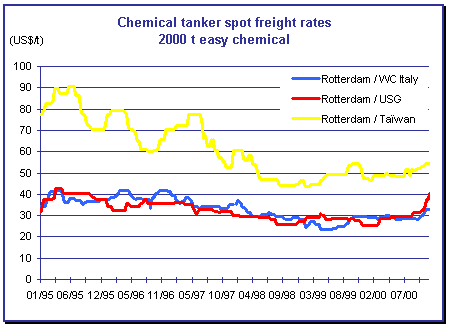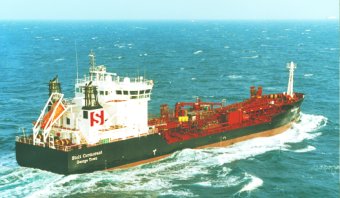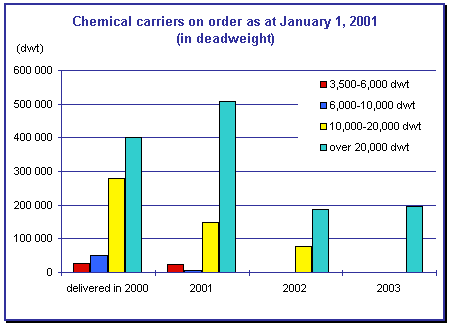
The Chemical Carrier market
in 2000 |
|
|
The year 2000 was globally not a good one for a
majority of shipowners, in terms of profitability. Many of them finished
the year in the red, while others were just balanced. The final results
hinged mainly on a number of factors ranging from the level of coverage
under contracts, the exchange rates and the inclusion or not of a
bunkering clause in their contracts.
The predominant cause of the poor returns for owners,
was the near doubling of bunker prices as compared to 1999. Shipowners
were caught unawares by this hike in fuel prices, especially when they
found that they were not able to pass on these increases within their
long term contracts, as the majority did not allow for a bunker price
revision. Likewise despite the higher spot freight rates this year on
most routes, they reflected little more than the higher bunker costs
being incurred.
During the first half of the year, the North European
market remained weak with freight rates down to 1999 levels. A revival
in activity was seen in the second half thanks to an increase in
contractual business, which helped to push up spot rates by some 10%. By
year end this tendency accentuated itself, and a further tightening of
rates led to increases of some 20-25% over the start of the year.
|
| The freight market |

|

With respect to the European short-sea traffic and
especially the North European/Mediterranean movements, as well as
inter-Mediterranean, the market remained very stable throughout the year
both in terms of volume and rates. The only exception to this was during
the past two months of the year, when quality vessels became scarce and
led to sudden jumps in freight rates. On the North
European/Mediterranean movement for 3,000 ton cargoes of easy chemicals,
rates remained around $26-27/ton up until October when they rose up to
and even above $ 30/ton by year end.
Over the same period traffic between West Coast
Italy/Rotterdam for 3,000 ton lots of easy chemicals were achieving $
25-26/ton compared to $24/ton at the beginning of the year.
On the US/Europe trade, after a promising start at
the beginning of the year the market tailed off somewhat towards the
end. A significant increase both in rates and volumes occurred during
the third quarter. Rates for 3,000 ton lots of easy chemicals between
Houston and Rotterdam ranged from a level of $34/ton at the beginning of
the year to around $ 39/ton at year's end. On the Europe/US routes the
market stayed calm throughout the year with only a few short-lived
variations. An increase in volumes and freight rates showed itself at
the start of the autumn. It is worth mentioning that on this route the
clean product market offers an interesting alternative to owners since
the middle of 2000.
In the 5-7,000 ton category of easy chemicals, rates
on the Rotterdam/Houston route went from $ 20/ton in January to $
28-29/ton in December.
As in the past, three or four shipowners operating
parcel tankers have continued to dominate the Europe/Far East market.
There has been no significant changes over the year on this market
either in terms of rates or volumes.
As an example freight rates for 3,000 ton cargoes of
easy chemicals outbound from Rotterdam to the major Far Eastern ports
remained around $55/ton throughout the year and $ 70/ton for lots of
1,000 tons requiring stainless steel tanks.
With regards to term contracts, which is
traditionally sketchy in this market, we can only report that the little
business concluded this year was for short periods, from 1 to 6 months,
and that rates reflected the considerable increase in spot rates. For
example newly-built stainless steel vessels of 8,000 dwt achieved levels
of around $ 8,000 per day and vessels of 12,000 dwt close to $ 9,500 per
day.
 |
STOLT CORMORAN
5,498 dwt, blt 1999 by INMA - Owned by Stolt-Nielsen |
|
| The fleet |

|
|
The fleet of chemical carriers continued to grow in
2000, although at a slightly reduced rate compared to the two previous
years, when more than 4million deadweight was delivered. This slowing
down in the fleet expansion is a direct consequence of the reduced
orders registered since the first half of 1998.
By end November 2000 the world chemical fleet
comprised 1,834 vessels with a combined deadweight of 25 million.
Following the arrival on the market of the large number of vessels
ordered in 1997 and beginning 1998, the chemical carrier fleet seems to
be slowly getting back into a more healthy balance. The number of
newbuildings on order has continued to decline, with 92 units for 1.5
million deadweight as of December 1st 2000, as compared to 120 vessels
the previous year.
46 vessels are due for delivery during 2001, and 22
for 2002 and beyond. There are a further 14 units being added in the
month of December 2000, of which some will probably slip into the new
year. Since January 2000, 49 new vessels have come into service with a
total deadweight of 729,358. The reduction in newbuilding orders has
been noticeable during 2000, when only 32 units have been placed by the
main operators since January 1st. Having undertaken an important
modernisation of their fleet over recent years, shipowners have been
particularly circumspect during 2000, contenting themselves mainly with
taking delivery of the previous years' orders. Only Jo Tankers and
Odjfell amongst the main operators have committed to newbuildings this
year.

Within the vessels dedicated to carrying chemicals
there has been an increasing number of oil product tankers which are
being refitted and particularly in the IMO II and III medium range
category, following the 'Erika' disaster. Since the beginning of the
year no less than 80 orders (three million dwt) have been placed with
Far East shipyards. These vessels with a capacity between 37,000- 48,000
dwt could compete with the stainless steel vessels for easy chemicals,
particularly should the product tanker market show signs of weakening.
The chemical carrier fleet is in delicate balance.
Despite a slight increase in scrapping during 2000, the number remains
modest. Even when markets were at their lowest, the level of scrapping
was negligible. Only eight vessels were demolished in 1997, three in
1998, and five in 1999 for a total deadweight total of less than 0.1
million. In 2000, 12 vessels left the fleet for 0.14 million dwt,
including the regrettable losses of both the 'Ievoli Sun' and the
'Martina'.
|
|

In summary it is apparent that towards the end of the
year, shipowners have sensed a mood of optimism. Even though chemical
carriers have been once again well behind the changes that have swept
through the crude oil and product tanker markets, nonetheless a number
of encouraging signs point to a more healthy and profitable situation
for owners in the near future. Not only is there a significant increase
in spot rates since the end of 2000, but also as could be expected the
renewal of contracts for 2001 have seen freight rates up by 10 to 15 %,
and in some cases even more. This should give shipowners a well-needed
breathe of fresh air, after nearly being suffocated by the price of
bunkers over the year.
Probably the most important development this year is
the decline in the deliveries of newbuildings combined with a drop in
the number of new orders. This should ensure that the market which has
been oversupplied for quite a time should gradually get back into a
better balance between supply and demand, and make for an easier
integration of delivery of new vessels into the market, with the ability
to maintain freight rates at respectable levels.
Finally following the recent accidents at
sea, there is special attention and importance now being placed on the
quality of vessels and their operators. In particular on movements which
require oil companies' approval, this will force the scrapping of
vessels which cannot comply to these new standards of age and security.
|
Shipping and Shipbuilding Markets in 2000
I N D E X
|